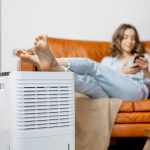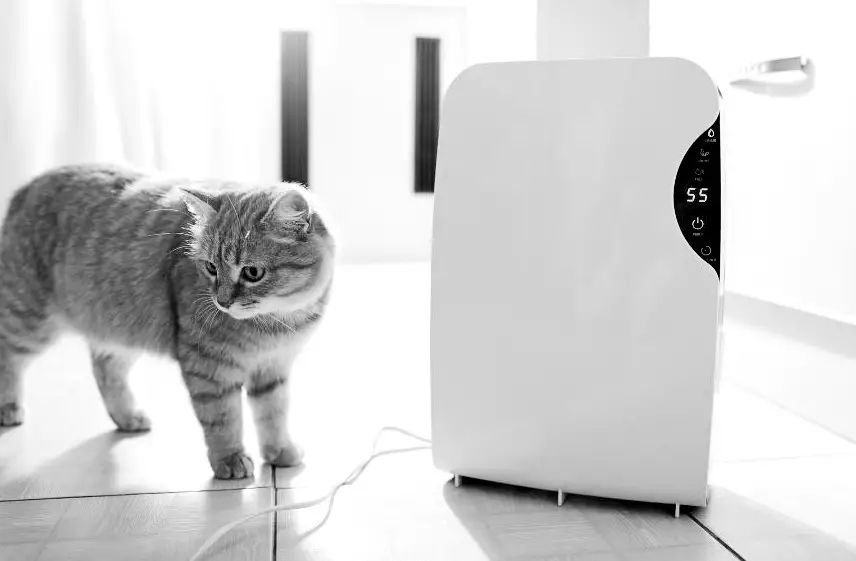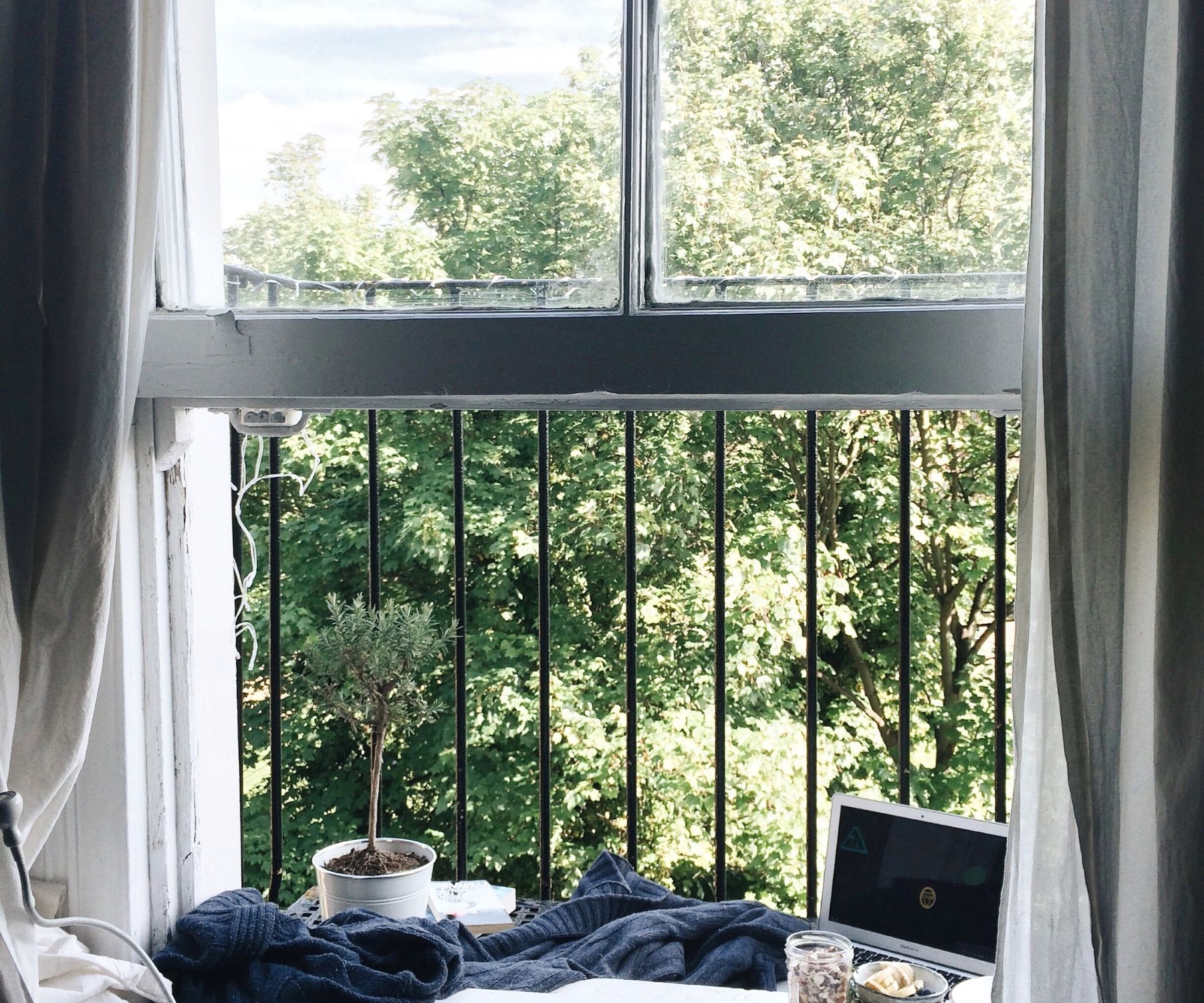Table of Contents
What do the numbers and symbols on a dehumidifier mean?
Dehumidifiers can be a mysterious device when you first attempt to navigate one.
The main number that appears illuminated on a dehumidifier is the relative humidity inside of the room where you have the device.
It’s the number that you are attempting to lower by using a dehumidifier.
According to the national library of medicine-PubMed, 40 to 60% relative humidity is the Ideal moisture level to avoid problems with either high or low humidity.
Dehumidifier Numbers and Settings
 Relative HumidityThe primary figure displayed on a dehumidifier indicates the relative humidity within the room where the device is placed. This is the value you aim to decrease by using a dehumidifier. Maintaining an optimal relative humidity level is essential to prevent issues associated with both excessive and insufficient humidity levels. Relative HumidityThe primary figure displayed on a dehumidifier indicates the relative humidity within the room where the device is placed. This is the value you aim to decrease by using a dehumidifier. Maintaining an optimal relative humidity level is essential to prevent issues associated with both excessive and insufficient humidity levels. |
 Fan Speed Often depicted by fan blade icons, with varying numbers of blades signifying different speed levels (e.g., one blade for low, two blades for medium, three blades for high). Fan Speed Often depicted by fan blade icons, with varying numbers of blades signifying different speed levels (e.g., one blade for low, two blades for medium, three blades for high). |
 Modes Some dehumidifiers have different modes, such as continuous mode, auto mode, and sleep mode. Modes Some dehumidifiers have different modes, such as continuous mode, auto mode, and sleep mode.
|
|
 Child Lock Prevents accidental changes to the controls. Child Lock Prevents accidental changes to the controls. |
|
 Filter Replacement Indicator Indicates that it is time to replace the filter. Filter Replacement Indicator Indicates that it is time to replace the filter. |
 Power Button Turns the machine on and off. Power Button Turns the machine on and off. |
 Reset button The reset button can be used when you have error codes, overheating, unexpected shutdowns, etc. Reset button The reset button can be used when you have error codes, overheating, unexpected shutdowns, etc. |
|
 How to Find and Set Dehumidifier Settings on an AC
How to Find and Set Dehumidifier Settings on an AC
On some air conditioners (AC units), you may find a dehumidifier setting. Here’s how to locate and adjust it:
- Look for the remote control or control panel on your air conditioner.
- Check for a “Mode” or “Settings” button. Press it to access the different modes or settings available.
- Search for the “Dehumidifier” or “Dry Mode” option among the modes/settings. This mode is designed to reduce humidity in the room.
- Select the “Dehumidifier” mode and set your desired humidity level if applicable. Some AC units allow you to adjust the target humidity level.
- Confirm your selection, and the AC will start operating in dehumidifier mode, helping to reduce excess moisture in the air.
Benefits of Using a Dehumidifier
Maintaining the ideal humidity levels in your home offers a range of advantages that contribute to a healthier and more comfortable living environment. Here are some key benefits of using a dehumidifier:
-
Improved Indoor Air Quality:
Allergen Reduction: Dehumidifiers help reduce common indoor allergens like dust mites, mold spores, and mildew. Lower humidity levels make it less hospitable for these allergens to thrive, leading to cleaner and healthier air.
Asthma and Allergy Relief: By minimizing airborne allergens, dehumidifiers can alleviate symptoms in individuals with asthma and allergies, promoting better respiratory health.
Less Odor: Lower humidity levels can help control musty odors often associated with damp environments, ensuring your home smells fresher and more pleasant.
-
Mold and Mildew Prevention:
Mold Growth Prevention: Excessive humidity is a primary factor contributing to mold and mildew growth in homes. Dehumidifiers can significantly reduce the risk of mold infestations on walls, ceilings, and other surfaces, protecting your home from structural damage and health hazards.
Healthier Living: Mold and mildew release spores that can trigger allergies and respiratory issues. A dehumidifier can help safeguard your family’s health by preventing the formation of these harmful substances.
-
Enhanced Comfort:
Temperature Regulation: Maintaining the optimal humidity level in your home can make it feel more comfortable even at slightly higher temperatures. When the air is less humid, your body’s natural cooling mechanisms, like sweating, become more effective, allowing you to stay comfortable without lowering the thermostat.
Reduction in Stickiness: High humidity levels can make you feel sticky and uncomfortable, especially during the summer months. Dehumidifiers can alleviate this discomfort, making your living space more enjoyable.
Preservation of Belongings: Lower humidity levels can also protect your furniture, electronics, and other possessions from moisture-related damage and deterioration.
-
Energy Efficiency:
Energy Savings: Dehumidifiers can contribute to energy savings by making your air conditioning more efficient. When the air is less humid, your AC doesn’t have to work as hard to cool the space, potentially lowering your energy bills.
-
Structural Preservation:
Home Maintenance: By reducing excess moisture in your home, dehumidifiers help preserve the structural integrity of your house. High humidity levels can lead to rot, warping, and corrosion in building materials.
-
Peace of Mind:
Reduced Health Concerns: Knowing that your indoor air quality is optimal and that mold and mildew growth are being prevented can provide peace of mind for you and your family’s health and well-being.
Are dehumidifiers safe to leave on?
Dehumidifiers are safe to leave on because they almost all exclusively come with an auto shut-off that turns the machine off when the bucket or the basin is full of water. That means you’re not going to come home to a floor full of water if you happen to leave the house with your humidifier running.
 Should I run a fan with a dehumidifier?
Should I run a fan with a dehumidifier?
Running a fan and a dehumidifier at the same time can be advantageous because both the fan and a dehumidifier have a drying effect on the air. After all, if you have done a recent painting project that you need to dry faster, you would probably put a fan blowing on it to help it do so.
The same goes for drying your hair, if you want to dry it faster, you can sit in front of a fan or better yet use a hair dryer. Which is essentially a hot fan.
A fan will also help move the humid air in a room towards the dehumidifier where it can do its job better. And the entire purpose of a dehumidifier is to extract moisture from the air to dry it. Not to mention that the two can be purchased together in one unit. So there is no conflict in using a fan and a humidifier at the same time.
Should I run a dehumidifier with an air conditioner?
Using a dehumidifier at the same time as an air conditioner can actually help reduce the wear and tear on your air conditioner because even though an air conditioner dehumidifies as it cools, it has to work harder when the air is extra humid.
Running a dehumidifier can take the strain off of an air conditioner and help it cool easier. But, remember dehumidifiers operate much like a window air conditioner that exhaust heat out of the rear.
Which helps with the humidification process but tends to make the room they are running in feel a little swampy. So if you’re using a portable dehumidifier, the room that you place the dehumidifier on is not exactly going to feel cooler even though the air conditioning may be working better.
How to know if you need a humidifier or dehumidifier?
If you live in an area that is typically dry, then higher humidity is easy to identify. Your skin is clammy and your hair is frizzy. But if you’re used to living in an area where high humidity is part of the climate, you may not even be aware that your humidity is spiking.
A hygrometer is a gauge that is designed to tell you what the relative humidity is inside of a room or your house. If the humidity inside your home is above 60%, then running a dehumidifier is needed to bring that number down below the 60% mark.
Is it okay to sleep in a room with a dehumidifier?
Sleeping in the same room as a dehumidifier doesn’t have any adverse effects health-wise, there is no threat of dehydration or anything that will harm you but… Dehumidifiers can be compared to running a window air conditioner. If you’ve ever walked behind a window air conditioner, you probably remember feeling the heat coming off of the rear of the machine. Dehumidifier works much the same only the heat that comes off the rear of it does not expel outside but inside of


 Timer Some dehumidifiers have a timer that you can use to set it to run for a certain amount of time. This can be useful if you want to dehumidify a room for a short period of time.
Timer Some dehumidifiers have a timer that you can use to set it to run for a certain amount of time. This can be useful if you want to dehumidify a room for a short period of time. TemperatureIf your dehumidifier has a temperature display or control, it will likely use the standard Fahrenheit (°F) or Celsius (°C) symbols.
TemperatureIf your dehumidifier has a temperature display or control, it will likely use the standard Fahrenheit (°F) or Celsius (°C) symbols. How to Find and Set Dehumidifier Settings on an AC
How to Find and Set Dehumidifier Settings on an AC Should I run a fan with a dehumidifier?
Should I run a fan with a dehumidifier?





